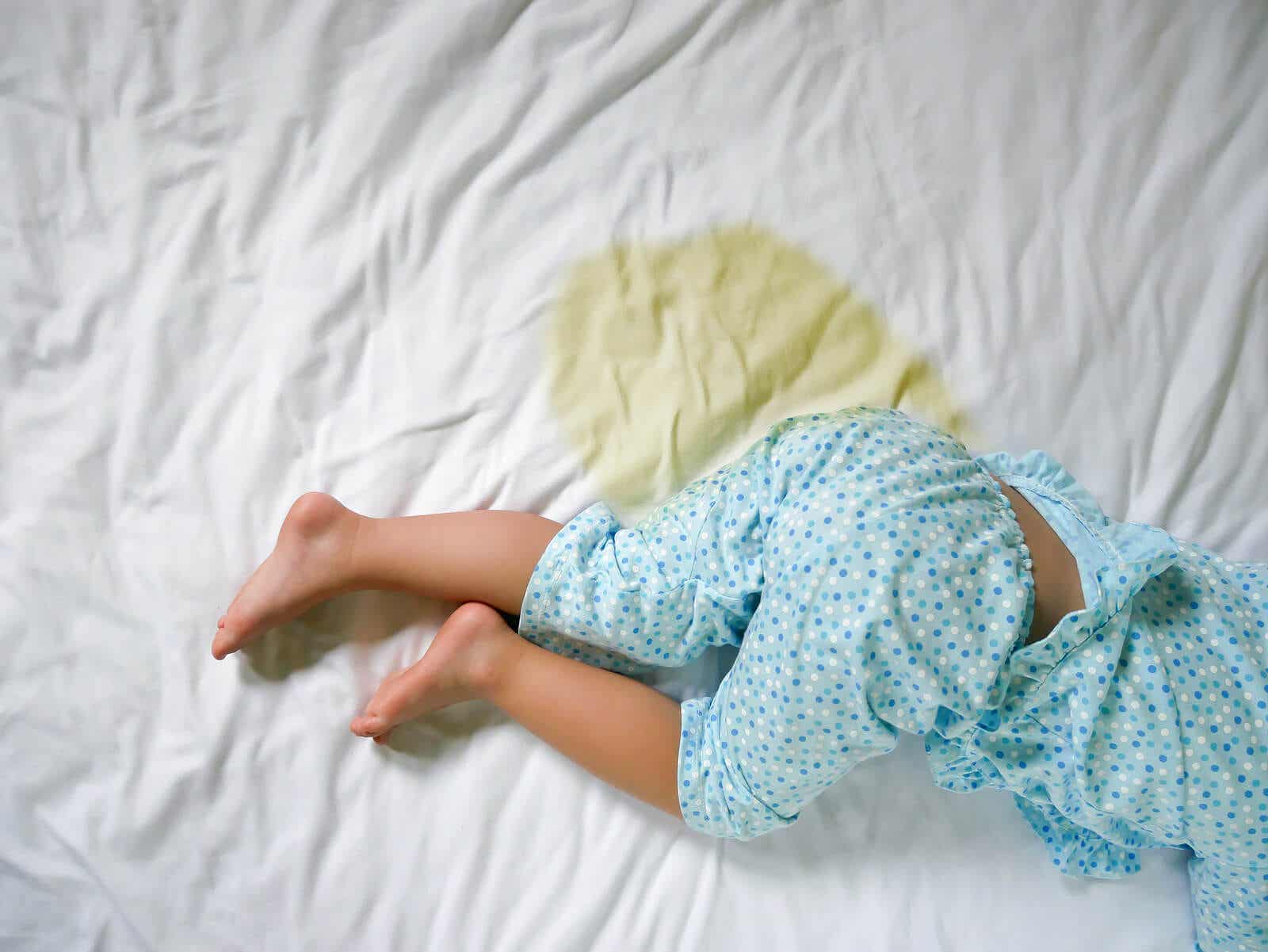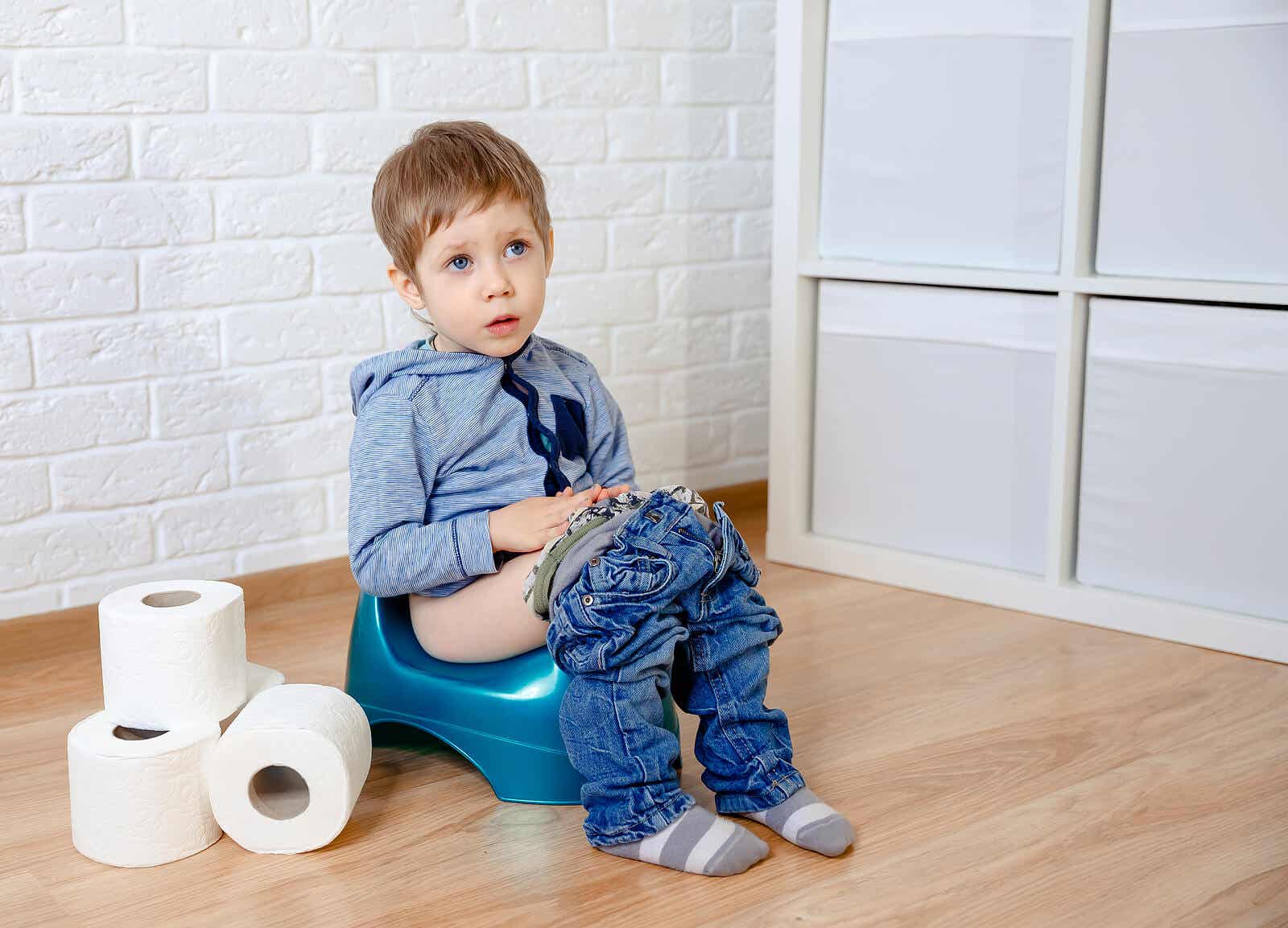The Pee-Stop Method: What Does It Consist Of?

The pee-stop method is a technique that aims to put an end to nocturnal enuresis. It’s a technique that involves classical conditioning with which the child learns by means of a stimulus. But we must be very careful with this method, as it could damage the child’s self-esteem. Toilet training is a natural process and each child’s particular rhythm is something we must respect.
What’s the pee-stop method?
Pee-stop is a method that uses a smart alarm clock’s so that the child learns to control urination through conditioning. It’s designed for children over 5 years old to teach them to stop urinating at night.
This method usually lasts between 4 and 12 weeks, and ensures an 80 to 90% success rate. You can also apply the method using a normal alarm clock to wake the child up every two hours to urinate. Or you can use a small box that attaches to the child’s pajamas with a switch and a humidity sensor at the end of a cable.

The moisture sensor is small and an underwear liner’s inserted, which attaches to the child’s underwear. When the child starts to urinate and the first drop wets the sensor, the buzzer will sound. This will cause the child to wake up quickly and with a start, which will, in some cases, stop the urination.
Why is pee-stop not always a good option?
The first thing to keep in mind is that, with this device, the child may feel that they’re doing something wrong. They’ll think that peeing at night is something negative in them.
And this can make them feel guilty and even damage their self-esteem. It’s completely normal for a child to urinate at night, even after the age of 7. Therefore, you need to respect your child’s developmental rhythm.
Nocturnal enuresis can occur due to many factors, such as emotional stress, diseases such as diabetes, having a smaller bladder, or even heredity. Relying on a device in these cases to try to stop nighttime urination is completely counterproductive. And this is especially true when there’s a medical cause that requires treatment.
Pee stop: A learning process that can be emotionally damaging
This learning is based on punishments and frustration because the child pees involuntarily so, as a result, it damages the child’s self-esteem. Learning may very well occur after many failures and many nightly interruptions, but children need to sleep. Moreover, it’s not a natural learning process, which can cause the child to feel great frustration.
It’s important to reinforce the child’s autonomy and to make them pee before going to bed and as soon as they wake up. Even if the child has to wear a diaper at night, you should never reprimand them.
In this sense, when the child wakes up with a dry diaper for several weeks in a row, you can encourage them to trust in their own toilet training. This way, you’ll strengthen their self-esteem and they’ll know that they’re the protagonist of the change and of their evolution.
Is there anything good about this method?
Although, as we’ve mentioned, this method has many cons, we can’t deny that there’s also some advantage to using it only for a short period of time.

For example, parents can know at what times their child usually pees during the night and write it down. This way, they can lovingly wake up their little one at those times to go to the bathroom and then space those times out gradually until they’re able to last the whole night without peeing.
But this is a very small advantage because it involves interrupting your sleep and that of your child. What’s more, you’ll be undermining the self-esteem of your little one, who’ll think that they’re not capable of doing things on their own.
Parents need to be aware that this process depends on their physiological maturation and not on their ability to control. Only in this way will parents be able to better understand their children and not blame them because they wet the bed or their pants.
Help your child to control nocturnal enuresis
Of course, as parents, you have the opportunity to help your child to control nighttime urination without having to follow the pee-stop method. The first thing to keep in mind is to boost your child’s self-esteem and self-confidence. For example, you can do this through children’s stories in which peeing at night is normalized. That way, you can find solutions through motivation and not punishment.
Your child will need you throughout their life to overcome different stages, and this is one of them. As they get older, you may need to help them with other things, such as making friends or preparing a speech to give in front of the whole school. It’s important that they feel that you’re by their side, with unconditional love and support, not punishment.
The pee-stop method is a technique that aims to put an end to nocturnal enuresis. It’s a technique that involves classical conditioning with which the child learns by means of a stimulus. But we must be very careful with this method, as it could damage the child’s self-esteem. Toilet training is a natural process and each child’s particular rhythm is something we must respect.
What’s the pee-stop method?
Pee-stop is a method that uses a smart alarm clock’s so that the child learns to control urination through conditioning. It’s designed for children over 5 years old to teach them to stop urinating at night.
This method usually lasts between 4 and 12 weeks, and ensures an 80 to 90% success rate. You can also apply the method using a normal alarm clock to wake the child up every two hours to urinate. Or you can use a small box that attaches to the child’s pajamas with a switch and a humidity sensor at the end of a cable.

The moisture sensor is small and an underwear liner’s inserted, which attaches to the child’s underwear. When the child starts to urinate and the first drop wets the sensor, the buzzer will sound. This will cause the child to wake up quickly and with a start, which will, in some cases, stop the urination.
Why is pee-stop not always a good option?
The first thing to keep in mind is that, with this device, the child may feel that they’re doing something wrong. They’ll think that peeing at night is something negative in them.
And this can make them feel guilty and even damage their self-esteem. It’s completely normal for a child to urinate at night, even after the age of 7. Therefore, you need to respect your child’s developmental rhythm.
Nocturnal enuresis can occur due to many factors, such as emotional stress, diseases such as diabetes, having a smaller bladder, or even heredity. Relying on a device in these cases to try to stop nighttime urination is completely counterproductive. And this is especially true when there’s a medical cause that requires treatment.
Pee stop: A learning process that can be emotionally damaging
This learning is based on punishments and frustration because the child pees involuntarily so, as a result, it damages the child’s self-esteem. Learning may very well occur after many failures and many nightly interruptions, but children need to sleep. Moreover, it’s not a natural learning process, which can cause the child to feel great frustration.
It’s important to reinforce the child’s autonomy and to make them pee before going to bed and as soon as they wake up. Even if the child has to wear a diaper at night, you should never reprimand them.
In this sense, when the child wakes up with a dry diaper for several weeks in a row, you can encourage them to trust in their own toilet training. This way, you’ll strengthen their self-esteem and they’ll know that they’re the protagonist of the change and of their evolution.
Is there anything good about this method?
Although, as we’ve mentioned, this method has many cons, we can’t deny that there’s also some advantage to using it only for a short period of time.

For example, parents can know at what times their child usually pees during the night and write it down. This way, they can lovingly wake up their little one at those times to go to the bathroom and then space those times out gradually until they’re able to last the whole night without peeing.
But this is a very small advantage because it involves interrupting your sleep and that of your child. What’s more, you’ll be undermining the self-esteem of your little one, who’ll think that they’re not capable of doing things on their own.
Parents need to be aware that this process depends on their physiological maturation and not on their ability to control. Only in this way will parents be able to better understand their children and not blame them because they wet the bed or their pants.
Help your child to control nocturnal enuresis
Of course, as parents, you have the opportunity to help your child to control nighttime urination without having to follow the pee-stop method. The first thing to keep in mind is to boost your child’s self-esteem and self-confidence. For example, you can do this through children’s stories in which peeing at night is normalized. That way, you can find solutions through motivation and not punishment.
Your child will need you throughout their life to overcome different stages, and this is one of them. As they get older, you may need to help them with other things, such as making friends or preparing a speech to give in front of the whole school. It’s important that they feel that you’re by their side, with unconditional love and support, not punishment.
All cited sources were thoroughly reviewed by our team to ensure their quality, reliability, currency, and validity. The bibliography of this article was considered reliable and of academic or scientific accuracy.
- Bragado Álvarez, C. (2009) Enuresis nocturna: Tratamientos eficaces. Editorial: Pirámide
- Alcázar, A. I. R., Meca, J. S., Rodríguez, J. O., & Martínez, F. M. (1998). La intervención conductual de la enuresis en España: una revisión meta-analítica. Análisis y modificación de conducta, 24(96), 557-578. https://dialnet.unirioja.es/descarga/articulo/7076973.pdf
This text is provided for informational purposes only and does not replace consultation with a professional. If in doubt, consult your specialist.








